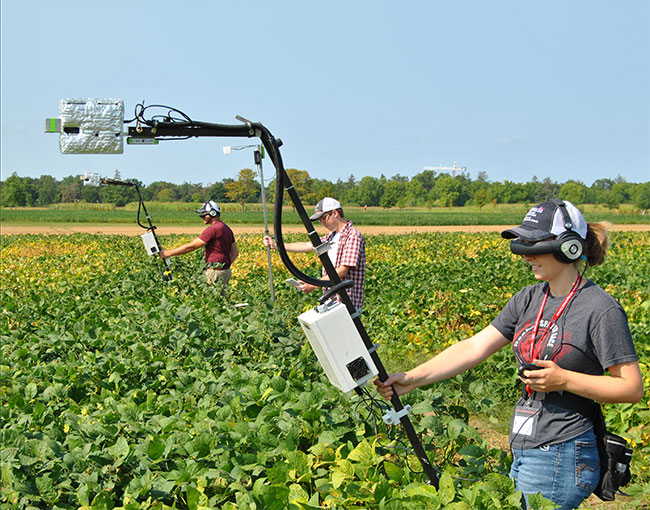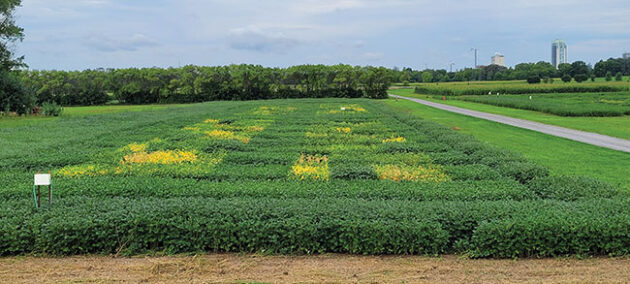
Features
Soybeans
Soybeans with better tolerance to low moisture
Prolonging nitrogen fixation under dry conditions to boost soybean yield and protein.
February 6, 2024 By Carolyn King
 With the innovative PlotCam, two operators capture light in different parts of the spectrum to evaluate canopy characteristics, while the middle operator uses another imagery method to measure canopy height.
Photos courtesy of Malcolm Morrison, AAFC.
With the innovative PlotCam, two operators capture light in different parts of the spectrum to evaluate canopy characteristics, while the middle operator uses another imagery method to measure canopy height.
Photos courtesy of Malcolm Morrison, AAFC. Soybean gets much of its nitrogen through a partnership with nitrogen-fixing bacteria that live in nodules on the plant’s roots. But the biological process of fixing atmospheric nitrogen and converting it into a form that the plant can use is sensitive to low soil moisture. Now, research is underway to accurately identify soybean lines that continue to fix nitrogen even when the weather turns dry.
This trait is known as prolonged nitrogen fixation under moisture stress (PNF). It has the potential to boost soybean yield and protein yield, and improve yield stability – all vital goals for Canadian soybean production.
“We have found that, over the past 100 years, precipitation in Canadian soybean-growing regions has become more irregular, making periodic moisture stress more and more of a reality for our soybean crops,” explains Malcolm Morrison, a research scientist with Agriculture and Agri-Food Canada (AAFC) in Ottawa.
“We define periodic moisture stress as a period of at least two weeks without significant rainfall, which really depletes the moisture content in the soil profile. There are three growth stages where periodic moisture stress can limit soybean yield: early vegetative growth, flowering, or seed development.”
Traits for tolerating dry conditions
“Leading plant physiologists have come up with five major traits that can assist soybean in tolerating moisture stress,” notes Morrison.
“One of these traits is slow wilt. Slow wilt is a general reduction in transpiration rates in the plant for the entire growing season.” This trait reduces the amount of water lost through the stomata (plant pores), even when soil moisture is abundant.
“Another trait is fast wilt. With fast wilt, the plant functions normally, but it has a higher threshold for when wilt, or the closing of stomata, occurs. The plant regulates the amount of water in it by really quickly closing the stomata.
“A soybean plant can also change the rate of its rooting depth extension. And it can change the speed of its growth; for instance, it can alter the rate of leaf area development.
“And finally, there is this prolonged nitrogen fixation under moisture stress.”
He adds, “Researchers have looked at soybean nitrogen fixation and biomass production under different moisture conditions. When they reduced the soil moisture content, they found that nitrogen fixation cuts out faster than biomass accumulation. The idea behind prolonging nitrogen fixation under moisture stress is to get nitrogen fixation up on par with this biomass accumulation.”
Not all of the five drought-tolerance traits are also advantageous under wet growing conditions. “A drought-tolerance trait that is beneficial only in dry years is no use to farmers because growing conditions are not always dry. If there is a yield penalty when conditions are normal or wet, then the farmer is not going to grow that variety,” cautions Morrison.
He notes that research led by Thomas Sinclair at the University of Florida looked at the effects of these five traits on soybean yields under different weather conditions. “They took 50 years of weather data for the entire soybean-growing regions in the United States, and they modelled what the outcome would be if these traits were incorporated into the soybean varieties. For instance, they found that the root extent trait and the leaf appearance trait actually tended to result in decreased yields in normal or wetter years.”
Out of the five traits, the PNF trait had the greatest yield benefits. Morrison says, “They found that, in a wet year, lines with the PNF trait yielded about 300 to 700 kilograms per hectare more than the average variety grown in that environment. And in a dry year, the PNF lines yielded about 500 to 900 kilos per hectare more. That’s a huge amount.”

These Ottawa trials are assessing soybean lines for prolonged nitrogen fixation under moisture stress. In the foreground, the plots in the block on the left are irrigated, while the ones on the right are dryland.
Identifying PNF lines
The PNF trait is fairly uncommon in soybeans, but some lines from the southern U.S. carry it. Elroy Cober, the soybean breeder at AAFC-Ottawa, has been crossing and backcrossing some of this U.S. material with his maturity group (MG) 0 and 00 lines to develop PNF lines suited to Canadian growing conditions. The progeny are currently being evaluated in the field.
But how can you tell which lines actually carry the PNF trait?
“The PNF trait is likely controlled by multiple genes, and no molecular markers are available to screen for this trait. Also, you can’t determine the presence of the trait just by looking at the plants,” notes Morrison.
“The purpose of our project is to help plant breeders by developing a selection process in the field whereby we can say with surety which plants have this PNF trait.”
Morrison is evaluating 14 of the AAFC lines that potentially have the PNF trait and two check varieties. The checks are: a non-nodulating soybean line, meaning that it doesn’t develop nodules and cannot perform biological nitrogen fixation; and a sister line that can nodulate.
He and his research team are growing these 16 lines in the field at the Ottawa Research and Development Centre under irrigated and dryland conditions. The irrigated plots have abundant moisture, avoiding any moisture stress, while the dryland plots typically undergo at least some moisture stress during the growing season.
“For example, in 2023, we got a lot of rain in August, while June and July were relatively dry. We got lower yields than normal because dry conditions prior to flowering limit the number of flowers that the plant will develop and the number of seeds that can develop from those flowers.”
The team is evaluating several different tests to find the optimal way to reliably identify PNF lines.
One of their approaches is to look at the yield difference between a soybean line when grown under irrigated conditions versus dryland conditions. A line with the PNF trait will have nearly the same grain yield and same protein yield under dryland conditions as under irrigated conditions.
Their second test is to measure the concentration of a nitrogen compound called ureide in the stem and petioles at the R5 growth stage (beginning of seed development). U.S. researchers have found that if this ureide concentration is high during dry conditions, then a feedback mechanism kicks in so that nitrogen fixation in the nodules shuts off. So, soybean lines with low ureide concentrations under dry conditions have the PNF trait.
The third way is to determine the ratio of two key nitrogen (N) isotopes – N14 and N15 – in the seed and in the stem at R5. “A line that has predominantly biological nitrogen fixation will have a very low N15 signature. A line that has a lot of nitrogen coming from a mineral source will have higher N15 amounts,” Morrison explains.
“For instance, our control plant that doesn’t fix nitrogen at all will have all of its nitrogen from mineral nitrogen, so it will have a higher N15 signature. Any lines that have the same amount of nitrogen coming from biological nitrogen fixation under dryland conditions as under irrigated conditions may have this PNF trait.”
The fourth test is to measure the amount of hydrogen emitted from the nodules. “Soybean nodules produce ammonia, NH4, which is toxic to a plant. So, the plant immediately cleaves off one of the hydrogen ions, producing ammonium, NH3. The cleaved-off hydrogen is released into the soil around the roots. By measuring the amount of hydrogen that is emitted, you get an indication of the amount of biological nitrogen fixation.”
Yet another approach is to use imaging technologies to measure light in the red, green, blue and infrared wavelengths, as well as recording stereo depth images, to capture data on things like canopy biomass, temperature, height and greenness.
In particular, they want to see if they can use the plant’s green spectral signature to select for the PNF trait. “Nitrogen is needed for chlorophyll, and chlorophyll is correlated to greenness. So, the amount of nitrogen in the plant will affect the chlorophyll content and the greenness,” he says. Plants without the PNF trait should have less greenness when grown under moisture stress.
To use this imaging approach, Morrison and his team have developed an innovative device called the PlotCam. This low-cost, hand-held tool includes a WiFi-controlled camera and a computer. It is designed to take images of field plots from above, and can be adjusted to capture imagery from many heights. It enables fast, repeatable collection of high-resolution image data so users can track changes in the plots over time.
Morrison suspects that the optimal testing procedure for the PNF trait might turn out to involve more than one of these tests, such as a combination of the ureide concentration and the N14/N15 ratio.
His PNF project is funded by Grain Farmers of Ontario with matching funds from AAFC under the Sustainable Canadian Agricultural Partnership (Sustainable CAP). He is collaborating on this research with Yvonne Lawley at the University of Manitoba. With funding from the Manitoba Pulse and Soybean Growers, Lawley is conducting exactly the same tests in Manitoba, and her research group is also doing the ureide analysis for both projects. Lawley and Morrison have a University of Manitoba master’s student, Larissa Cottick, working on this research.
Broad potential benefits
Morrison’s project already has some promising initial findings. “Out of the 14 soybean lines, we have identified some that have both high yield and high protein yield under dryland conditions,” he notes.
He also plans to look at the economic benefit of having the PNF trait in soybean varieties. “If we find a line that we know has prolonged nitrogen fixation under dry conditions, then we can compare the yield under abundant moisture and under dry conditions and determine how much extra it will be yielding than the average varieties that don’t have this trait.”
Morrison emphasizes that the PNF trait is important for building resilience to the effects of climate change into our soybean varieties. He notes that climate change is not just about hotter temperatures, but also about increasing variability, with more extremes in temperature, both hotter and colder, and in precipitation, both wetter and drier.
“This PNF trait is very important in that it doesn’t have a yield penalty in a normal or wet year, and it has a yield benefit in a dry year, compared to a variety without this trait.”
Morrison believes the PNF trait will be of interest to large and small soybean breeding programs across Canada and globally. “Our growing world population is going to need protein,” he says. “Incorporation of this trait would be a benefit for the entire world, not just Canadian farmers.”